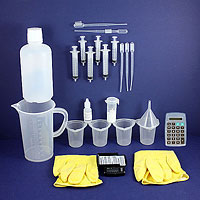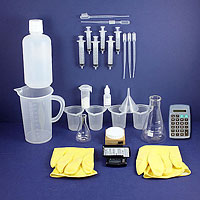

|
|
|

INTRODUCTION
When making Biodiesel, there are several tests that you can do to ensure you produce high quality Biodiesel. This page will cover several tests that we believe are great to integrate into your Biodiesel production routine. If followed, they will help you not only make great Biodiesel, but will also help you understand what is happening at all stages of the Biodiesel production process and how to deal with any problems that may arise. The page is structured into stages of the production process to make the tests easy to follow. QUALITY TESTS INDEX PRODUCTION STAGE 1: OIL COLLECTION & PREPARATION - WATER CONTENT - BIODIESEL TITRATION PRODUCTION STAGE 2: AFTER OIL COLLECTION, BEFORE PROCESSING - METHANOL PURITY (If using recovered methanol) PRODUCTION STAGE 3: AFTER PROCESSING, BEFORE WASHING - 3/27 BIODIESEL CONVERSION TEST PRODUCTION STAGE 4: AFTER PROCESSING, AFTER WASHING - SOAP CONTENT - WATER CONTENT ASTM TESTING (The Commercial Biodiesel Quality Standard) ADDITIONAL TESTS PRODUCTION STAGE 1: OIL COLLECTION & PREPARATION | BACK TO TOP QUALTY TEST: WATER CONTENT | BACK TO TOP Recommended Limit: Below 2500 PPM (or 0.25 % By Volume) Reason For Test: This test looks for water content in the oil. If extremely wet is used to make Biodiesel, the water will mix with the catalyst (Sodium or Potassium Hydroxide) and begin forming soap out of the oil. When soap is formed it robs the catalyst from being able to fully react the oil into Biodiesel resulting in poorly converted fuel. Excess soaps in Biodiesel can also potentially lead to unwanted emulsions during the washing process. Description Of Tests: Test #1: HOT PAN TEST (Accurate To Approximately 500 PPM, 0.05%) Test #2: QUANTITATIVE WATER TEST (Accuracy Dependent On Measuring Devices) Test #3: SANDY BRAE WATER TEST (Accurate To 50 PPM, 0.005%) Link to video Click on the video above to see how to use a Sandy Brae Water Test Kit  Click here to learn more about the Sandy Brae Deluxe Water Test Kit QUALTY TEST: BIODIESEL TITRATION (Testing Oil For Acid Content) | BACK TO TOP Recommended Limit: NaOH Titrations - <= 6, KOH Titration - <=9 Reason For Test: When making Biodiesel, it's important to know what the acid level in the oil is. This is because when Biodiesel is produced, one of the chemicals used will be a strong base. Typically Sodium or Potassium Hydroxide. If the oil is very acidic, you'll need to compensate for this by adding more base than normal to make the reaction occur. This is because part of your base chemical will be neutralized by the acid in the oil. By knowing the acid content you'll be able to add enough extra base chemical so that there's enough left over after neutralizing the acid to still make Biodiesel. The method used to measure the acid content in the oil is called a Titration. It's performed by taking a sample of oil, adding it to some pH neutral alcohol, typically isopropyl alcohol, adding a pH indicator to the mixture and then slowly adding measured amounts of a solution of water with a small amount of the strong base chemical that you'll be using to produce your Biodiesel with. Once the basic solution neutralizes the acid in the oil, the pH will go higher (low pH = acidic solution, high pH = basic solution), indicating that it's been neutralized. The pH indicator will then turn a different color to let you know that you've neutralized the acid. There are several types of pH indicators that can be used to do a Biodiesel titration, but the most common is Phenolphthalein. Phenol Red and Turmeric can also be used as well. Description Of Test: Additional Test Information: Titration Method 


Click here to see all three of these kits PRODUCTION STAGE 2: AFTER OIL PREPARATION, BEFORE PROCESSING | BACK TO TOP QUALTY TEST: METHANOL PURITY | BACK TO TOP Recommended Limit: 99.5% Pure Or Better Reason For Test: Occasionally if methanol sits for long periods of time it can absorb moisture from the air. If your methanol has been sitting for a while or if you've recovered the methanol, we recommend testing it for purity. Usually, the impurity in Methanol is water. As in the case of oil, having water in the process can potentially lead to soap production and potentially poorly reacted Biodiesel. Description Of Test: Click on the video to see a test demonstration We offer two complete Methanol Purity Testing Kits PRODUCTION STAGE 3: AFTER PROCESSING, BEFORE WASHING | BACK TO TOP QUALTY TEST: 3/27 BIODIESEL CONVERSION TEST | BACK TO TOP Recommended Limit: No Fallout Reason For Test: This test is used to identify how well reacted the Biodiesel is. It helps to let you know if the chemical reaction worked the way it was supposed to. If the fuel isn't well reacted, then it may need to be reacted again. Also, poorly reacted Biodiesel can be the cause of emulsions when water washing Biodiesel. This test has been well tested against the ASTM equivalent test (ASTM D6584) and found to correlate extremely well when performed correctly. We highly recommend this test be performed on every batch. This test can also be run after washing as well. Description Of Test: Example Tests: Additional Information: Video Example Of This Test Watch a free instructional video on how to perform this test! We offer a complete Biodiesel Conversion Test Kit for performing this test PRODUCTION STAGE: AFTER PROCESSING, AFTER WASHING | BACK TO TOP QUALTY TEST: SOAP CONTENT | BACK TO TOP Recommended Limit: NaOH Reacted Bio <=41 PPM, KOH Reacted Bio <= 66 PPM Reason For Test: When Biodiesel is produced, a certain amount of soap gets produced right along with it. When the Biodiesel is properly washed, soap levels should be greatly reduced. To ensure the Biodiesel is finished being washed, we recommend testing the soap content of your Biodiesel. If soap levels are still high, the Biodiesel can be rewashed. Special Note If You Dry Wash Biodiesel Description Of Test: Additional Information Video On Soap Testing We offer 3 complete Soap Content Test Kits for performing this test We also offer chemicals & labware separately for soap testing as well! QUALTY TEST: WATER CONTENT | BACK TO TOP Recommended Limit: Below 500 PPM (or 0.05% By Volume) Reason For Test: This test looks for water contet in the oil. If oil that is extremely wet is used to make Biodiesel, the water will mix with the catalyst (Sodium or Potassium Hydroxide) and begin forming soap out of the oil. When soap is formed it robs the catalyst from being able to fully react the oil into Biodiesel resulting in Biodiesel that may not be completely reacted. Also, excess soaps in Biodiesel can potentially lead to unwanted emulsions during the washing process. Description Of Tests: Test #1: HOT PAN TEST (Accurate To Approximately 500 PPM, 0.05%) Test #2: QUANTITATIVE WATER TEST (Accuracy Dependent On Measuring Devices) Test #3: SANDY BRAE WATER TEST (Accurate To 50 PPM, 0.005%) Link to video Click on the video above to see how to use a Sandy Brae Water Test Kit Click here to see the video in high resolution  Click here to learn more about the Sandy Brae Deluxe Water Test Kit ASTM LABORATORY TESTING (D6751 Panel) | BACK TO TOP Reason For Test: The Biodiesel ASTM Testing Panel (ASTM D 6751) is required to be performed on Biodiesel if it is going to be sold as a fuel for use in on-road vehicles. Results from these tests are required to be submitted to the EPA before a certificate to produce and sell Biodiesel commercially will be issued. The IRS also requires proof that your Biodiesel passes these tests before they'll allow you to take certain tax credits as well. Because the ASTM D6751 is the standard against which Biodiesel is tested (and must pass) before it's allowed to be sold commercially, many people that produce their own Biodiesel like to see "just how close" they are getting to this standard. In many cases, if good Biodiesel production techniques are practiced and the tests laid out above are used, it's possible to easily pass these tests. Description Of Tests: Additional Information: ASTM Defintion Of Biodiesel
Learn more about the ASTM Standard in this presentation from Gorge Analytical Link to video Download the presenation from the video ADDITIONAL QUALITY TESTS | BACK TO TOP There are actually quite a few additional tests that are used by Biodieselers in their quest to make great Biodiesel. While not all the tests we've seen are required specifically to make high quality Biodiesel, these additional tests can help you further understand what it is you've produced and possibly help you fix problems along the way. This list was complied by our good friend Rick over at B100 Supply. Click here to see a full list of tests |
|
MGBJ Enterprises, LLC - © Copyright 2005-2021 - All Rights Reserved - NX NEW |
|